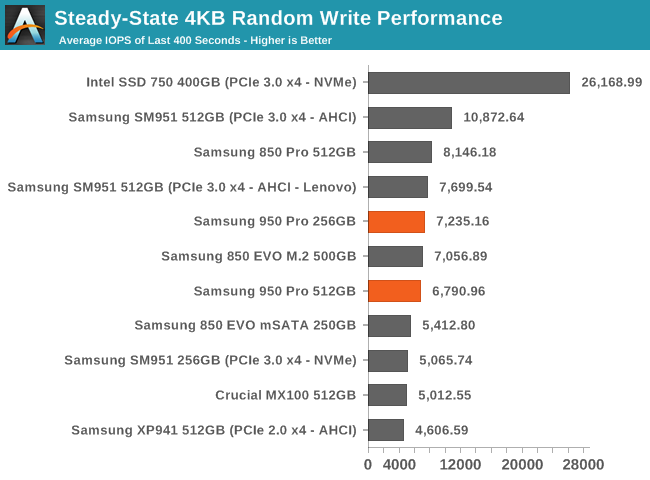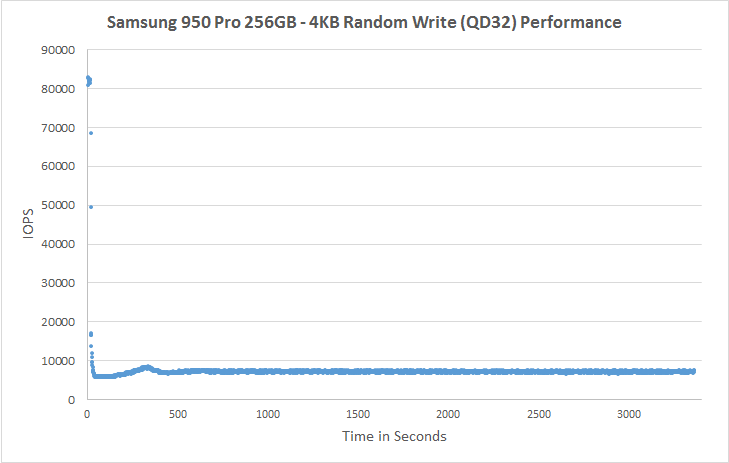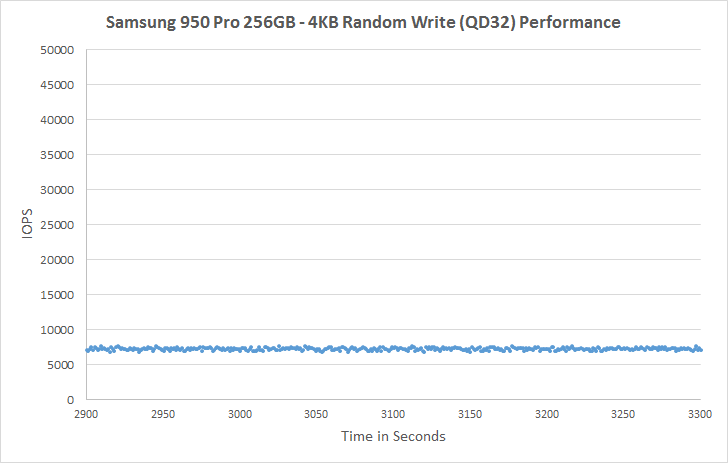The Samsung 950 Pro PCIe SSD Review (256GB and 512GB)
by Billy Tallis on October 22, 2015 10:55 AM ESTPerformance Consistency
Kicking things off, our performance consistency test saturates the drive with 4kB random writes for a full hour, with a queue depth of 32, the maximum supported by the AHCI protocol used by SATA and most PCIe drives. This puts the drive's controller under maximum stress and writes enough data to exhaust all free space and spare area on the drive. This is an unrealistic workload for any client use, but it provides a worst-case scenario for long-term heavy use, and it sheds light on how different SSD controllers behave and if their performance will hold up as they fill up.
The average of the last 400 seconds of the test gives us a steady-state IOPS rating that is usually very different from what the manufacturer specifies for a new, empty drive. We also quantify the consistency of the drive's random write performance, and provide plots of the performance over the course of the test.

Once steady state is reached, performance is determined more by the controller's algorithms than the interface speed, so it's not too surprising to see the 950 Pro performing similarly to other Samsung drives.

The consistency metric shows a surprising disparity between the two 950 Pros, with the 256GB performing much better.
 |
|||||||||
| Default | |||||||||
| 25% Over-Provisioning | |||||||||
Comparing the graphs of the two 950s shows that the inconsistency of the 512GB drive comes from frequent jumps in performance above a solid baseline. This pattern holds even for the test with overprovisioning. Graphing the power consumption over time (not shown) reveals that the periods of lower performance have lower power. If the lower performance were due to periodic background garbage collection, then we would expect power consumption to be at least as high as when the drive is performing well. Instead, it appears that the 512GB drive is experiencing thermal throttling.
 |
|||||||||
| Default | |||||||||
| 25% Over-Provisioning | |||||||||
With most of its time spent thermally limited, our 512GB sample's low average is explained. It appears that the thermal throttling mechanism is bumping the drive down to one of several discrete performance levels, rather than a continuous performance mechanism.










142 Comments
View All Comments
Gigaplex - Thursday, October 22, 2015 - link
It's unlikely Samsung is holding back, as the phenomenon is affecting all brands.ddriver - Monday, October 26, 2015 - link
Corporations do price fixing, why not performance fixing.niva - Wednesday, October 28, 2015 - link
It is possible to do performance fixing, but not likely in this case. Enterprise hardware should generally concentrate on endurance, probably using different binning and better memory. I'm sure they can beef up the drivers too and optimize for certain loads. In general they'll get the most sales by selling in greater numbers. Artificially limiting performance so they can make more profit margin on some (much smaller quantities) hardware being sold to enterprise doesn't make sense.That all being said I guess it is possible.
ShieTar - Monday, October 26, 2015 - link
Yes, there is a DRAM cache. The size of it is listed in the table on the first page of the article.Without this, random writes would still be horrible, as overwriting a complete 128KB block whenever the drive is supposed to write down just 4KB leads quickly to the need of reading, deleting & re-writing the blocks, as no unused 128KB-blocks are left.
Laststop311 - Tuesday, October 27, 2015 - link
its just part of how nand cells works. If you need faster speed 3d xpoint is coming to save the day.Per Hansson - Wednesday, October 28, 2015 - link
The DRAM cache is not used to cache writes.It's large size is mainly for the NAND mapping table.
If writes where cached in DRAM the performance of 4KB random writes would of course be waaay higher than what it is.
And quite extreme dataloss would occur in case of power loss.
virtualbigd - Wednesday, December 16, 2015 - link
Can you elaborate on your reliability point above, for Samsung?virtualbigd - Wednesday, December 16, 2015 - link
I know about 840 EVO, is there something else?Samus - Thursday, October 22, 2015 - link
I have my reservations over Samsung drives, especially since the 840 EVO, but DAMN.jay401 - Saturday, October 24, 2015 - link
Hey if you turn that V upside down, you have the first A-NAND SSD. :D